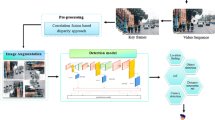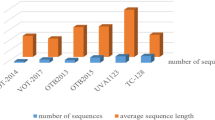Abstract
The rapid development in the field of computer vision has encouraged researchers to develop vision systems for moving object detection in embedded surveillance applications. The model requires a fast processing algorithm with minimum complexity, which also consumes less memory for computation. This paper proposes a fast moving object detection algorithm to aid foreground segmentation in embedded applications. Dimensionality based Grouping Particle Swarm Optimization-Motion Saliency Map, a variant of the PSO framework combined with saliency map technique is proposed to achieve tighter object detection. The presented technique utilizes the concept of saliency map followed by shadow removal, partial occlusion detection, and Local Difference Pattern based removed object detection. Dimensionality based Grouping Particle Swarm Optimization-Saliency Map of the background model and Dimensionality based Grouping Particle Swarm Optimization-Saliency Map of the incoming frame are used to construct Motion Saliency Map. The proposed model produces a tighter object region compared to the existing naive saliency map based methods. An enhanced texture feature extraction strategy, named as Local Difference Pattern is proposed for removed object detection. This presented moving object detection method is simple and efficient. It consumes less memory for computation. Hence, the algorithm is suitable for embedded surveillance applications. The experimental results show the effectiveness of the proposed method in terms of average processing time in addition to qualitative, and quantitative analyses.











Similar content being viewed by others
References
Allen JG, Xu RY, Jin JS (2004) Object tracking using camshift algorithm and multiple quantized feature spaces. In: Proceedings of the Pan-Sydney area workshop on visual information processing, pp 3–7. Australian Computer Society, Inc
Balcilar M, Sonmez AC (2016) Background estimation method with incremental iterative re-weighted least squares. SIViP 10(1):85–92
Braham M, Van Droogenbroeck M (2016) Deep background subtraction with scene-specific convolutional neural networks. In: 2016 international conference on systems, signals and image processing (IWSSIP), pp 1–4. IEEE
CDNET: http://wordpress-jodoin.dmi.usherb.ca/dataset2014/. Accessed January-2017
Chen Z, Ellis T (2014) A self-adaptive gaussian mixture model. Comput Vis Image Underst 122:35–46
Choudhury SK, Sa PK, Bakshi S, Majhi B (2016) An evaluation of background subtraction for object detection vis-a-vis mitigating challenging scenarios. IEEE Access 4:6133–6150
Dou J, Qin Q, Tu Z (2017) Background subtraction based on circulant matrix. SIViP 11(3):407–414
El Maadi A, Djouadi MS (2015) Using a light dbscan algorithm for visual surveillance of crowded traffic scenes. IETE J Res 61(3):308–320
Elgammal A, Harwood D, Davis L (2000) Non-parametric model for background subtraction. Computer Vision—ECCV 2000:751–767
Gao Z, Cheong LF, Wang YX (2014) Block-sparse rpca for salient motion detection. IEEE Trans Pattern Anal Mach Intell 36(10):1975–1987
Gemignani G, Rozza A (2016) A robust approach for the background subtraction based on multi-layered self-organizing maps. IEEE Trans Image Process 25(11):5239–5251
Han XH, Xu G, Chen YW (2013) Robust local ternary patterns for texture categorization. In: 2013 6th international conference on biomedical engineering and informatics (BMEI), pp 846–850. IEEE
Heikkilä M, Pietikäinen M, Heikkilä J (2004) A texture-based method for detecting moving objects. In: Bmvc, vol 401, pp 1–10
Itti L, Koch C, Niebur E (1998) A model of saliency-based visual attention for rapid scene analysis. IEEE Trans Pattern Anal Mach Intell 20(11):1254–1259
Jodoin JP, Bilodeau GA, Saunier N (2014) Urban tracker: Multiple object tracking in urban mixed traffic. In: 2014 IEEE winter conference on applications of computer vision (WACV), pp 885–892. IEEE
Lee BY, Liew LH, Cheah WS, Wang YC (2014) Occlusion handling in videos object tracking: A survey. In: IOP conference series: earth and environmental science, vol 18, p 012020. IOP Publishing
Lee G, Mallipeddi R, Jang GJ, Lee M (2015) A genetic algorithm-based moving object detection for real-time traffic surveillance. IEEE Signal Process Lett 22 (10):1619–1622
Li C, Bao Z, Wang X, Tang J (2018) Moving object detection via robust background modeling with recurring patterns voting. Multimed Tools Appl 77(11):13557–13570. https://doi.org/10.1007/s11042-017-4975-4
Lin HH, Chuang JH, Liu TL (2011) Regularized background adaptation: a novel learning rate control scheme for gaussian mixture modeling. IEEE Trans Image Process 20(3):822–836
Ma YF, Zhang HJ (2002) A model of motion attention for video skimming. In: 2002 international conference on image processing. 2002. Proceedings, vol 1, pp I–I. IEEE
Maddalena L, Petrosino A (2009) Self organizing and fuzzy modelling for parked vehicles detection. In: International conference on advanced concepts for intelligent vision systems, pp 422–433. Springer
Oliver NM, Rosario B, Pentland AP (2000) A bayesian computer vision system for modeling human interactions. IEEE Trans Pattern Anal Mach Intell 22(8):831–843
Pan Z, Liu S, Fu W (2017) A review of visual moving target tracking. Multimed Tools Appl 76(16):16,989–17,018
Paragios N, Deriche R (2000) Geodesic active contours and level sets for the detection and tracking of moving objects. IEEE Trans Pattern Anal Mach Intell 22 (3):266–280
Ramírez-Alonso G, Chacón-Murguía MI (2016) Auto-adaptive parallel som architecture with a modular analysis for dynamic object segmentation in videos. Neurocomputing 175:990–1000
Sajid H, Cheung SCS (2017) Universal multimode background subtraction. IEEE Trans Image Process 26(7):3249–3260
Seidel F, Hage C, Kleinsteuber M (2014) Prost: a smoothed∖ell _p-norm robust online subspace tracking method for background subtraction in video. Mach Vis Appl 25(5):1227–1240
Seo JW, Kim SD (2016) Dynamic background subtraction via sparse representation of dynamic textures in a low-dimensional subspace. SIViP 10(1):29–36
Sheikh Y, Shah M (2005) Bayesian modeling of dynamic scenes for object detection. IEEE Trans Pattern Anal Mach Intell 27(11):1778–1792
Shi Y, et al. (2001) Particle swarm optimization: developments, applications and resources. In: 2001 proceedings of the 2001 congress on evolutionary computation, vol 1, pp 81–86. IEEE
St-Charles PL, Bilodeau GA, Bergevin R (2015) A self-adjusting approach to change detection based on background word consensus. In: 2015 IEEE winter conference on applications of computer vision (WACV), pp 990–997. IEEE
St-Charles PL, Bilodeau GA, Bergevin R (2015) Subsense: A universal change detection method with local adaptive sensitivity. IEEE Trans Image Process 24 (1):359–373
St-Charles PL, Bilodeau GA, Bergevin R (2016) Universal background subtraction using word consensus models. IEEE Trans Image Process 25(10):4768–4781
Stauffer C, Grimson WEL (1999) Adaptive background mixture models for real-time tracking. In: IEEE computer society conference on. computer vision and pattern recognition, 1999, vol 2, pp 246–252. IEEE
Subudhi BN, Ghosh S, Ghosh A (2012) Object and shadow separation using fuzzy markov random field and local gray level co-occurence matrix based textural features. In: 2012 12th international conference on intelligent systems design and applications (ISDA), pp 95–100. IEEE
Sun Y, Tao X, Li Y, Lu J (2015) Robust 2d principal component analysis: A structured sparsity regularized approach. IEEE Trans Image Process 24(8):2515–2526
Wang Y, Jodoin PM, Porikli F, Konrad J, Benezeth Y, Ishwar P (2014) Cdnet 2014: an expanded change detection benchmark dataset. In: Proceedings of the IEEE conference on computer vision and pattern recognition workshops, pp 387–394
Woo JW, Lee W, Lee M (2010) A traffic surveillance system using dynamic saliency map and svm boosting. Int J Control Autom Syst 8(5):948–956
Wren CR, Azarbayejani A, Darrell T, Pentland AP (1997) Pfinder: Real-time tracking of the human body. IEEE Trans Pattern Anal Mach Intell 19(7):780–785
Yuan Q, Yin G (2015) Analyzing convergence and rates of convergence of particle swarm optimization algorithms using stochastic approximation methods. IEEE Trans Autom Control 60(7):1760–1773
Yubing T, Cheikh FA, Guraya FFE, Konik H, Trémeau A (2011) A spatiotemporal saliency model for video surveillance. Cogn Comput 3(1):241–263
Zeng Z, Jia J, Yu D, Chen Y, Zhu Z (2017) Pixel modeling using histograms based on fuzzy partitions for dynamic background subtraction. IEEE Trans Fuzzy Syst 25(3):584–593
Zhao Z, Zhang X, Fang Y (2015) Stacked multilayer self-organizing map for background modeling. IEEE Trans Image Process 24(9):2841–2850
Zhou X, Yang C, Yu W (2013) Moving object detection by detecting contiguous outliers in the low-rank representation. IEEE Trans Pattern Anal Mach Intell 35(3):597–610
Author information
Authors and Affiliations
Corresponding author
Additional information
Publisher’s Note
Springer Nature remains neutral with regard to jurisdictional claims in published maps and institutional affiliations.
Rights and permissions
About this article
Cite this article
Vijayan, M., Ramasundaram, M. A fast DGPSO-motion saliency map based moving object detection. Multimed Tools Appl 78, 7055–7075 (2019). https://doi.org/10.1007/s11042-018-6459-6
Received:
Revised:
Accepted:
Published:
Issue Date:
DOI: https://doi.org/10.1007/s11042-018-6459-6




